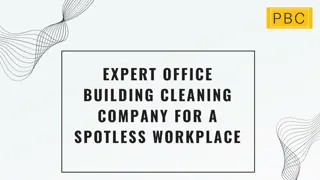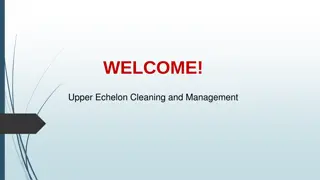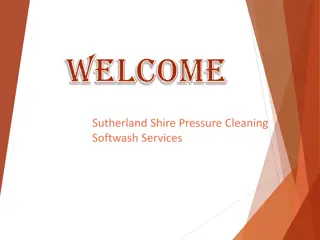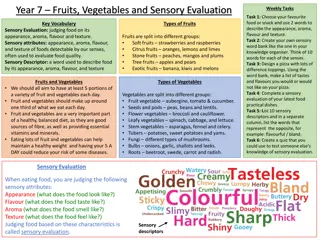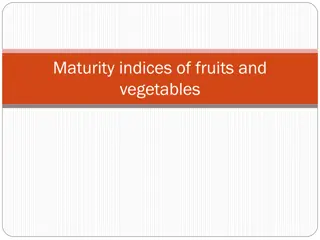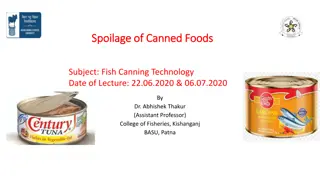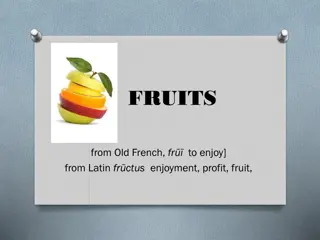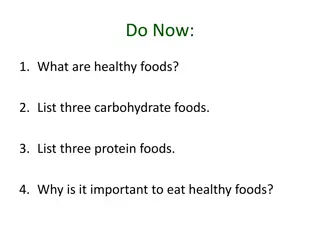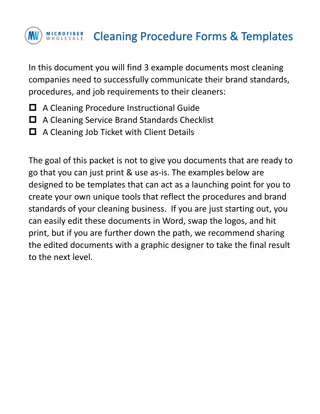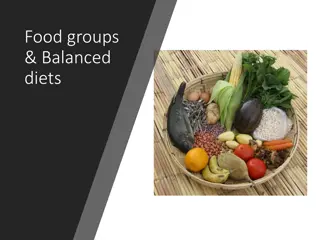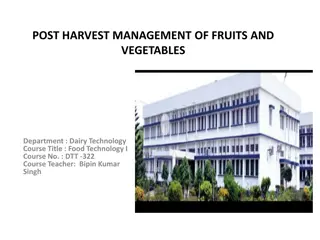Tips for Cleaning and Handling Fruits, Vegetables, and Canned Foods
Learn the best ways to clean fruits and vegetables, make an effective kitchen disinfectant, identify spoilage in canned foods, and understand recommended canning methods. These helpful tips will ensure food safety and quality in your kitchen.
Download Presentation

Please find below an Image/Link to download the presentation.
The content on the website is provided AS IS for your information and personal use only. It may not be sold, licensed, or shared on other websites without obtaining consent from the author. Download presentation by click this link. If you encounter any issues during the download, it is possible that the publisher has removed the file from their server.
E N D
Presentation Transcript
UCCE MFP Do you know? The best way to clean fruits and vegetables is to: Soak in warm soapy water for 10 minutes Soak in cold water for 5 minutes Rinse under running water Spray with commercial produce cleaner
UCCE MFP Do you know? The best way to clean fruits and vegetables is to: Soak in warm soapy water for 10 minutes Soak in cold water for 5 minutes Rinse under running water Spray with commercial produce cleaner
UCCE MFP Do you know? Which of the following mixtures will act as an inexpensive but effective kitchen disinfectant? 1 Tbsp chlorine bleach per gallon of water Tbsp chlorine bleach per gallon of water Tbsp chlorine bleach per pint of water 1 tsp chlorine bleach per pint of water 1 tsp chlorine bleach per pint of water
UCCE MFP Do you know? Which of the following mixtures will act as an inexpensive but effective kitchen disinfectant? 1 Tbsp chlorine bleach per gallon of water Tbsp chlorine bleach per gallon of water Tbsp chlorine bleach per pint of water 1 tsp chlorine bleach per pint of water 1 tsp chlorine bleach per pint of water
UCCE MFP Do you know? You can always tell if canned food has gone bad by the off color, putrid smell, or foul taste. True False
UCCE MFP Do you know? You can always tell if canned food has gone bad by the off color, putrid smell, or foul taste. True False
UCCE MFP Do you know? Which of the following canning methods are recommended by the USDA? Boiling water canning Steam canning Open kettle canning Pressure canning
UCCE MFP Do you know? Which of the following canning methods are recommended by the USDA? Boiling water canning Steam canning Open kettle canning Pressure canning
UCCE MFP Do you know? What determines if a food needs to be pressure canned? Altitude Acidity Density Ripeness
UCCE MFP Do you know? What determines if a food needs to be pressure canned? Altitude Acidity Density Ripeness
UCCE MFP Do you know? Which of the following foods do not need to be pressure canned to be shelf stable? Apples Beans Pickled beets Pumpkin Split pea soup Tomatoes
UCCE MFP Do you know? Which of the following foods do not need to be pressure canned to be shelf stable? Apples Beans Pickled beets Pumpkin Split pea soup Tomatoes
UCCE MFP Do you know? Which of the following foods must be pressure canned to be shelf stable? Butternut squash Chicken Fish Sauerkraut Tomatoes Vegetable soup
UCCE MFP Do you know? Which of the following foods must be pressure canned to be shelf stable? Butternut squash Chicken Fish Sauerkraut Tomatoes Vegetable soup
UCCE MFP Do you know? Which of the following food pathogens are destroyed at a boiling temperature? Yeasts Molds E. coli O157:H7 Clostridium botulinum
UCCE MFP Do you know? Which of the following food pathogens are destroyed at a boiling temperature? Yeasts Molds E. coli O157:H7 Clostridium botulinum
UCCE MFP Do you know? What inhibits Clostridium botulinum spores from creating the botulism toxin? Acid Dryness Oxygen Salt Sugar
UCCE MFP Do you know? What inhibits Clostridium botulinum spores from creating the botulism toxin? Acid Dryness Oxygen Salt Sugar
UCCE MFP Do you know? What temperature is needed to kill Clostridium botulinum spores? 160 F 212 F 240 F 260 F
UCCE MFP Do you know? What temperature is needed to kill Clostridium botulinum spores? 160 F 212 F 240 F 260 F





